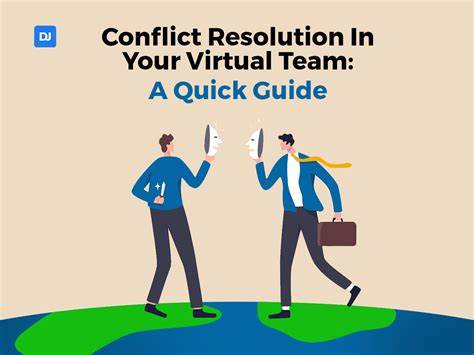
Introduction
Imagine a remote team working on a critical project with a tight deadline. The team consists of members from different time zones, including the U.S., Europe, and Asia. Communication primarily happens through emails, chat apps, and occasional video calls.
One team member, Alex, feels overwhelmed by the volume of messages and the lack of clear instructions. Meanwhile, Priya, another team member, is frustrated because Alex’s delayed responses are slowing down the project. The tension escalates when Priya sends a strongly worded message, and Alex responds defensively. Other team members start taking sides, affecting team morale and productivity.
The team leader, Maria, steps in to mediate. She schedules a video call, encourages open communication, and helps Alex and Priya understand each other’s perspectives. Maria proposes using a shared project management tool and setting “core hours” for real-time communication. With these changes, the team starts to function more smoothly, and the conflict is resolved.
Thesis Statement
Resolving conflicts in remote teams is crucial for maintaining team morale, productivity, and effective communication. The unique challenges of remote work, such as lack of face-to-face interaction, time zone differences, and cultural diversity, require tailored strategies to ensure that conflicts are addressed promptly and constructively, fostering a collaborative and harmonious work environment.
Understanding Remote Team Conflicts
Types of Conflicts
Communication Issues: Misunderstandings and misinterpretations often arise due to the lack of face-to-face interaction and reliance on written communication, which can lead to conflicts.
Cultural Differences: Diverse cultural backgrounds can result in different communication styles, work ethics, and expectations, potentially causing friction among team members.
Misaligned Goals: When team members have different priorities or understandings of project goals, it can lead to conflicts over the direction and execution of tasks.
Time Zone Challenges: Working across different time zones can create delays in communication and collaboration, leading to frustration and conflicts.
Resource Allocation: Disputes can occur when team members feel that resources, such as time, budget, or support, are not being distributed fairly.
Personality Clashes: Differences in personalities and working styles can lead to conflicts, especially when team members have strong opinions or different approaches to problem-solving.
Performance Issues: Conflicts can arise when team members perceive others as not contributing equally or meeting performance expectations.
Impact of Unresolved Conflicts on Remote Team Morale and Productivity
Team Morale
Increased Stress and Frustration: Unresolved conflicts can lead to heightened stress and frustration among team members, creating a tense and uncomfortable work environment.
Decreased Motivation: When conflicts persist, team members may feel demotivated and disengaged, leading to a lack of enthusiasm for their work.
Erosion of Trust: Ongoing conflicts can erode trust between team members, making it difficult to collaborate effectively and build strong working relationships.
Productivity
Distraction from Tasks: Conflicts can distract team members from their tasks, causing them to spend more time dealing with interpersonal issues rather than focusing on their work.
Reduced Efficiency: The negative atmosphere created by unresolved conflicts can lead to reduced efficiency, as team members may be less willing to cooperate and share information.
Increased Absenteeism: Persistent conflicts can result in higher absenteeism rates, as team members may take more sick days or avoid work to escape the stressful environment.
Higher Turnover Rates: Unresolved conflicts can contribute to higher turnover rates, as employees may choose to leave the organization rather than continue working in a contentious environment.

Effective Communication Strategies
Using clear and consistent communication tools is essential for remote teams to function effectively. Email, chat apps, and video calls each serve unique purposes and, when used appropriately, can prevent misunderstandings and ensure that everyone is on the same page.
Consistent use of these tools helps establish a routine and clear expectations for communication, reducing the chances of important information being overlooked. For instance, emails can be used for detailed, formal communication, chat apps for quick, informal exchanges, and video calls for more personal, face-to-face interactions.
By leveraging these tools effectively, remote teams can maintain strong connections, foster collaboration, and address issues promptly, ultimately enhancing overall productivity and team cohesion.
Conflict Resolution Techniques
Identify the Root Cause: Identifying underlying issues in remote team conflicts requires a systematic approach of active listening, observing communication patterns, and conducting confidential one-on-one discussions. Look beyond surface-level disagreements to uncover root causes such as misaligned expectations, communication gaps, unclear roles, technological frustrations, or unaddressed personal tensions. Use diagnostic questions that encourage honest reflection, pay attention to emotional undertones in digital interactions, and analyze patterns of disengagement or passive resistance that might signal deeper organizational or interpersonal challenges.
Mediation and Facilitation: Managers can play a crucial role as mediators in resolving conflicts within remote teams by facilitating discussions and helping team members find common ground. Here’s how they can do it effectively:
Steps for Managers to Mediate Conflicts
- Create a Safe Environment: Ensure that all team members feel comfortable expressing their thoughts and concerns without fear of judgment or retaliation. This can be achieved by setting ground rules for respectful communication and confidentiality.
- Encourage Open Communication: Actively listen to each team member’s perspective and encourage them to share their views openly. Use techniques like paraphrasing and summarizing to show understanding and validate their feelings.
- Identify Common Goals: Help the team focus on shared objectives and common interests. By highlighting mutual goals, managers can shift the focus from personal differences to collective success.
- Facilitate Constructive Dialogue: Guide the conversation in a positive direction by asking open-ended questions and encouraging team members to propose solutions. Avoid taking sides and remain neutral throughout the discussion.
- Address Underlying Issues: Work with the team to identify and address the root causes of the conflict. This may involve exploring deeper issues such as miscommunication, cultural differences, or misaligned expectations.
- Develop Action Plans: Collaborate with the team to develop actionable steps to resolve the conflict. Ensure that all parties agree on the plan and understand their roles and responsibilities in implementing it.
- Follow Up: Monitor the situation and follow up with the team to ensure that the agreed-upon solutions are being implemented and that the conflict has been resolved. Provide ongoing support and make adjustments as needed.
By acting as mediators, managers can help their remote teams navigate conflicts effectively, fostering a more collaborative and harmonious work environment.
Setting Ground Rules
Establishing clear guidelines for respectful communication and behavior is essential for fostering a positive and productive remote team environment. These guidelines should outline expectations for how team members interact with each other, emphasizing the importance of professionalism, empathy, and active listening. By setting standards for respectful communication, such as using polite language, avoiding interrupting others, and addressing conflicts constructively, teams can minimize misunderstandings and reduce the potential for conflicts. Additionally, these guidelines should encourage inclusivity and respect for diverse perspectives, ensuring that all team members feel valued and heard. Clear communication guidelines help create a supportive atmosphere where everyone can collaborate effectively and contribute to the team’s success.
Special Offer!

Leveraging Technology
- Use of Collaboration Tools: Highlight tools that can help manage conflicts (e.g., project management software, shared documents).
- Anonymous Feedback: Suggest using anonymous surveys to gather honest feedback from team members.
- Virtual Team Building: Recommend activities that can strengthen team bonds and reduce conflicts.
Case Studies and Examples
- Real-Life Examples: Provide brief case studies of successful conflict resolution in remote teams.
- Lessons Learned: Share key takeaways from these examples that managers can apply to their own teams.
Conclusion
- Recap Key Points: Summarize the main strategies and techniques discussed.
- Call to Action: Encourage managers to implement these strategies to improve their remote team dynamics.
I hope you found this article informative and helpful,
Don Merrill, Leadership Coach/Mentor
Don@CoachingSkillsforLeaders.org

PS: please share your thoughts in the comments below and/or repost this article for others to read. Thank you!
Related Articles:
Settling Conflicts in a Remote-Work World – This article from SHRM discusses the challenges of managing conflicts in a remote work environment and offers insights into how to handle digital disputes effectively.
4 Triggers Cause the Majority of Team Conflicts – Published by Harvard Business Review, this article explores the main triggers of team conflicts and provides strategies for managing them, especially in remote settings.
Tension Is Rising Around Remote Work – Another insightful piece from Harvard Business Review, this article delves into the increasing tensions around remote work and offers steps for leaders to facilitate open discussions and find balanced solutions.
12 Proven Strategies for Resolving Conflicts Within a Remote Team – This article from Lead Grow Develop provides practical strategies from founders and CEOs on how to maintain harmony and resolve conflicts within remote teams.
Resolving Conflict in Remote Teams – Growthspace.com offers actionable strategies to identify and address systemic issues that drive conflict in distributed teams.
Related Books:
Here are some excellent books on conflict resolution, particularly in the context of remote teams:
https://amzn.to/49oCa9iCrucial Conversations: Tools for Talking When Stakes Are High by Kerry Patterson, Joseph Grenny, et al. This book provides strategies for having tough discussions and maintaining composure during emotional exchanges.
Difficult Conversations: How to Discuss What Matters Most by Douglas Stone, Bruce Patton, and Sheila Heen offers insights into navigating challenging conversations and resolving conflicts effectively.
Getting to Yes: Negotiating Agreement Without Giving In by Roger Fisher, William Ury, and Bruce Patton is a classic guide on negotiation and conflict resolution, emphasizing win-win solutions.
The Five Dysfunctions of a Team: A Leadership Fable by Patrick Lencioni explores common team dysfunctions and provides practical advice for building cohesive and effective teams.
